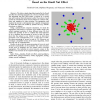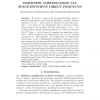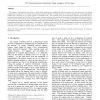17 search results - page 3 / 4 » Simulating a Random Walk with Constant Error |
BMCBI
2005
13 years 7 months ago
2005
Background: Many complex random networks have been found to be scale-free. Existing literature on scale-free networks has rarely considered potential false positive and false nega...
IROS
2009
IEEE
14 years 2 months ago
2009
IEEE
— We study a simple algorithm inspired by the Brazil nut effect for achieving segregation in a swarm of mobile robots. The algorithm lets each robot mimic a particle of a certain...
CC
2008
Springer
13 years 7 months ago
2008
Springer
We prove a version of the derandomized Direct Product lemma for deterministic space-bounded algorithms. Suppose a Boolean function g : {0, 1}n {0, 1} cannot be computed on more th...
ICASSP
2011
IEEE
12 years 11 months ago
2011
IEEE
In this work, the tracking analysis of the Normalized Least Mean Fourth (NLMF) algorithm is investigated for a random walk channel under very weak assumptions. The novelty of this...
NN
1998
Springer
13 years 7 months ago
1998
Springer
The number of required hidden units is statistically estimated for feedforward neural networks that are constructed by adding hidden units one by one. The output error decreases w...



